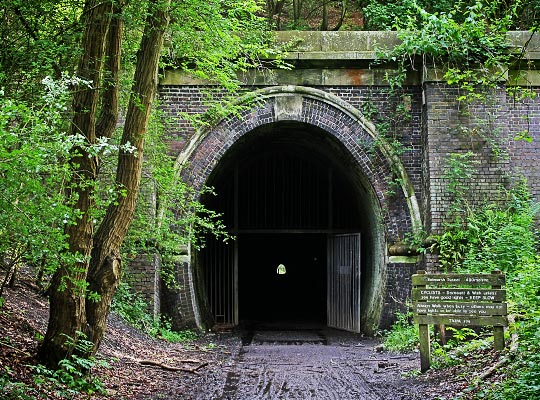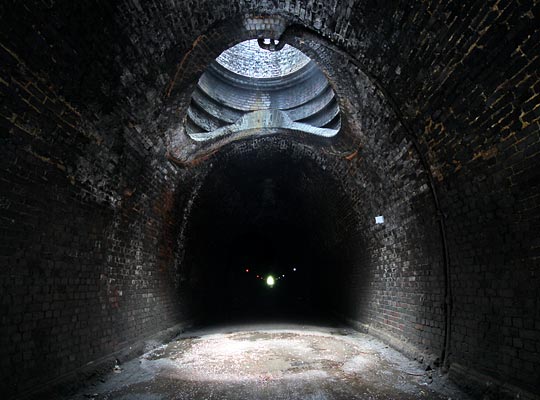Kelmarsh Up Tunnel
Kelmarsh Up Tunnel


















In the early 1850s, the London & North Western Railway promoted a line linking Northampton with Market Harborough, the intention being to capitalise on the huge amounts of ironstone found in the area. The route was engineered by George R Stephenson, nephew of his famous namesake, and George Parker Bidder. Work got underway in 1856, with Richard Dunkley of Blisworth awarded the contract to build it. 16th February 1859 brought its official opening.
The single line was forced to penetrate hills at Kelmarsh and Great Oxendon, the former being driven through strong blue clay. On Sunday 11th April 1858, Sergeant Rawson from the local constabulary attended Kelmarsh Tunnel and found Thomas Thompson busy assembling some timber centres, whilst four other labourers loaded bricks into a wagon. All were charged with working on a Sunday, despite the engineer protesting that their exertions were necessary in order to correct a defect in the tunnel. Each was subsequently fined five shillings; the contractor paid costs totalling £2 7s 6d.
Due to increasing traffic levels, the route was doubled in 1879, demanding second bores to be constructed on the east side of the originals, used by Up trains. The navvies involved dug deep into their pockets, contributing more than £5 towards an appeal to cover running costs for Northampton’s General Infirmary.
The bores share combined portals at both ends. These are imposing and architecturally attractive structures, built mostly in brick. Notable features are the substantial buttresses either side of the entrances and curved wing walls. The detailing is stone, including the parapet, associated string course and oversail around the arch ring face that protects it from water penetration. Above the parapets are lengthy drainage channels, also brick-built. The bores themselves are horseshoe-shaped in profile and in generally fair condition.
In Kelmarsh’s 520-yard Up tunnel, the ballast has been removed to provide a more comfortable surface for users of the 14-mile Brampton Valley Way footpath which opened in spring 1993. No lighting is provided, although the bore is straight and reflective plates have been attached to the sidewalls to help guide walkers towards the exit. There is also a central shaft which throws a puddle of light onto the solum. At the surface, the brick protection wall is located in a field just to the north of Top Lodge Farm. The refuges have been bricked-up to prevent members of the public lurking in them. Conditions are generally dry but some puddling does occur following periods of wet weather.
Next door, Kelmarsh Down Tunnel – also 520 yards long – has suffered considerable brickwork deterioration over the years, causing open mortar joints and spalling. During its operational period, this prompted extensive repointing and many patch repairs, including the replacement of two lengthy sections of arch in engineering brick.
Towards the southern end, the lining is predominantly soot-covered; however water ingress has resulted in smaller accumulations further north. A collection of weep pipes – inserted at springing level – allow water to escape from behind the brickwork. Most of these have associated calcite deposits.
The refuges are tall, thin and built with brick inverts. White plates were installed on both sides of them to improve their visibility to any platelayers working inside the tunnel. Along the Down sidewall, rows of cable hooks remain in situ. Two distinct kinks in the alignment are apparent close to the north portal, presumably caused by setting-out errors. These had implications on structure gauge and contributed to the tunnels’ notoriously restricted clearances.
Although freight continued to run, passenger traffic was originally withdrawn from the route on 4th January 1960. However through services were restored for four months in the early part of 1969, and between July 1972 and August 1973. But the line was allowed to decline, with poor track conditions resulting in speed restrictions as low as 15mph; the linespeed generally was 45mph. It finally succumbed to closure on 16th August 1981, with a return charter special running the previous day.
Click on this icon for a gallery of Kelmarsh Down Tunnel pictures.
Click on this icon for a gallery of Oxendon Tunnel pictures.
Click on this icon for a gallery of infrared pictures.








